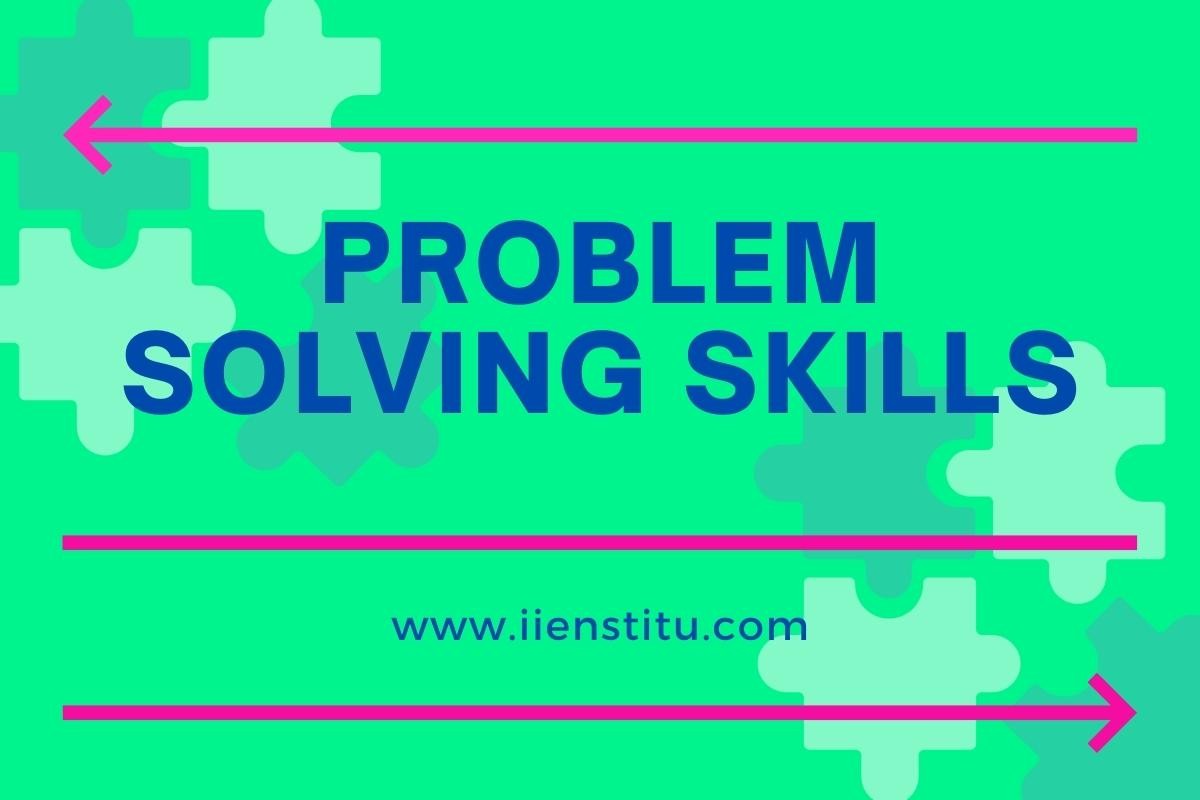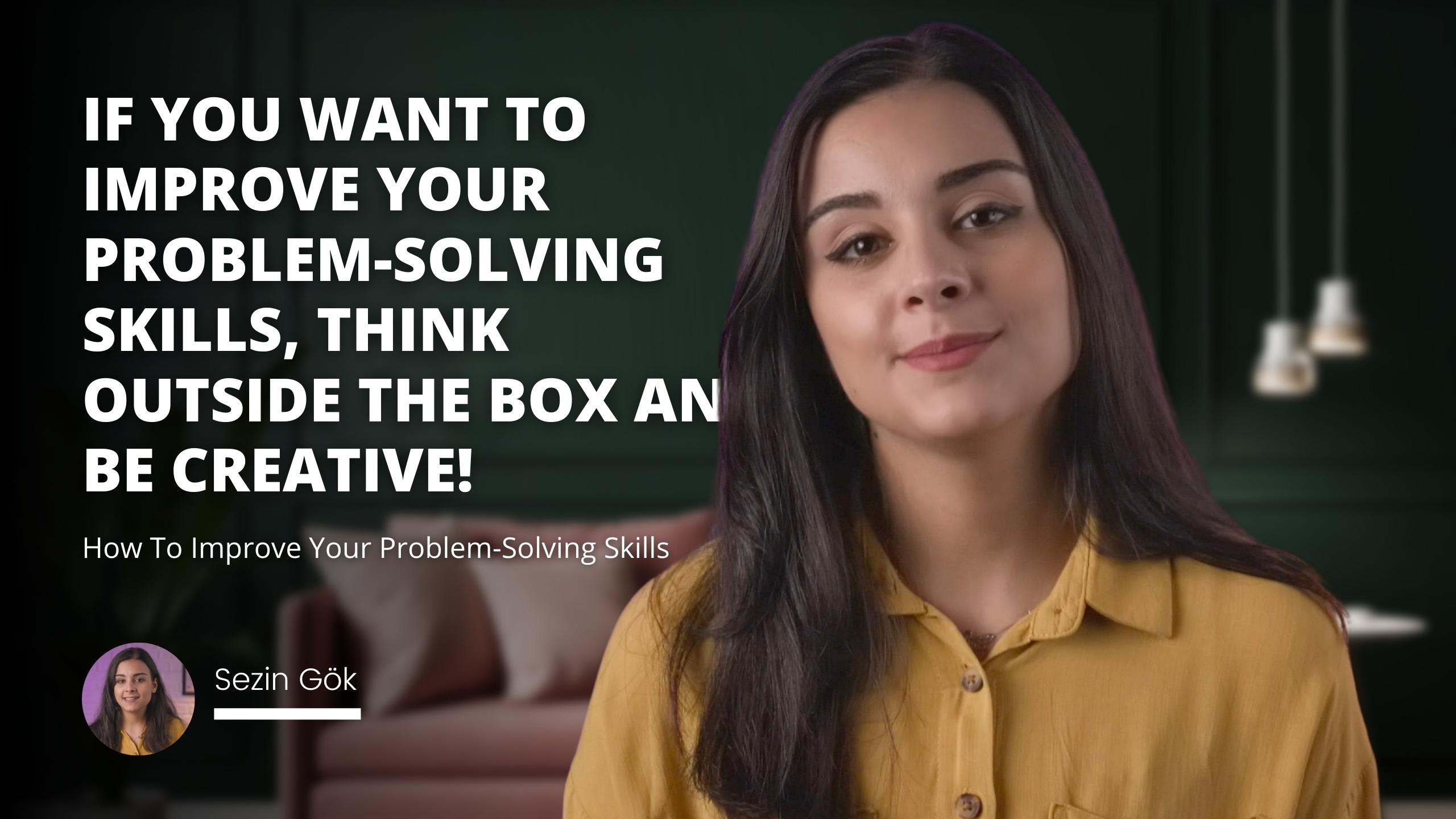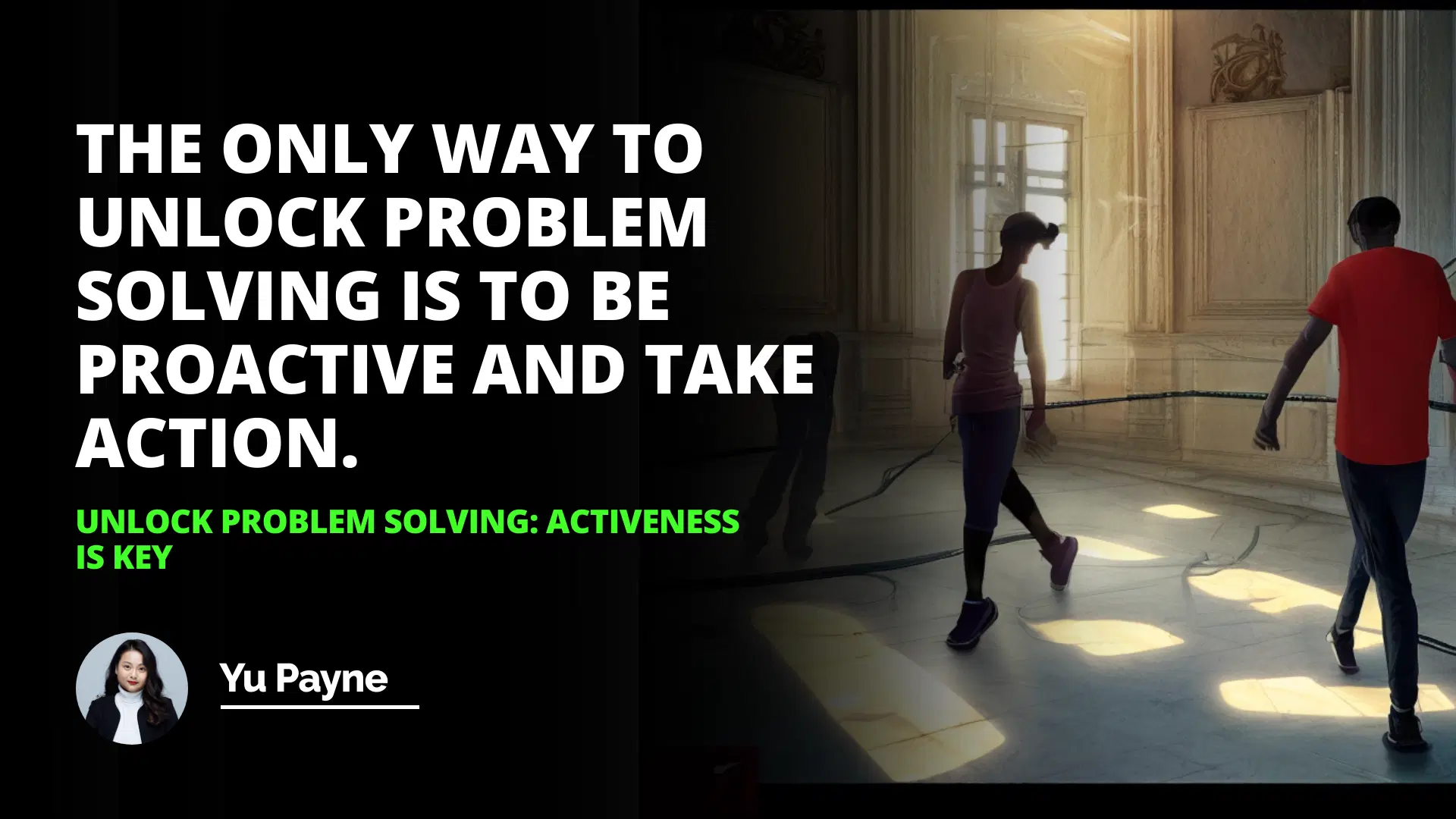
I still remember the day when I was sitting in my high school math class, staring blankly at a complex algebra problem on the blackboard. It felt like staring into an abyss—completely overwhelming and utterly confusing. But then, something clicked. Instead of fixating on the numbers and symbols, I began to visualize the problem. I imagined it as a puzzle waiting to be pieced together. By creating a mental picture, I transformed an abstract concept into something tangible. From that day forward, I realized the power of being active in problem-solving.
The Journey from Confusion to Clarity
We've all been there, haven't we? Faced with a problem that seems insurmountable at first glance. Good problem solvers, though, have a knack for diving deeper. They're like detectives, piecing together clues, asking questions, and exploring every angle. In contrast, poor problem solvers might throw their hands up in frustration, feeling lost and defeated.
Introduction
Activeness in Problem Solving
Creating a Mental Picture
Asking Questions
Conclusion
Actively Engaging with Problems
Being active in problem-solving isn't just about finding a solution; it's about immersing oneself in the process. When I was in college, I struggled with a particularly challenging physics course. The theories were dense, and the equations seemed never-ending. But I noticed that my friend, Alex, always seemed to grasp the concepts with ease. One day, I asked him his secret.
"Well," he said, "I don't just read the textbook. I actively engage with the material. I draw diagrams, ask myself questions, and try to relate everything to real-world scenarios."
His approach resonated with me. Instead of passively reading, he was interacting with the content, making it his own.
Steps to Active Problem Solving:
1- Create a Mental Picture: Visualize the problem in your mind or sketch it out.
2- Ask Questions: Don't hesitate to question every aspect of the problem.
3- Break It Down: Divide the problem into smaller, more manageable parts.
What Are Personal Development Plans And How Can They Help Me Achieve Success
Unlocking Problem Solving Skills With Expert Systems Aı And Machine Learning
4- Relate to Real-Life: Connect abstract concepts to familiar experiences.
5- Use Physical Aids: Write things down, use diagrams, or even physical objects.
The Power of Visualization
There's an old saying, "A picture is worth a thousand words."
When dealing with complex problems, creating a mental image can be incredibly beneficial. For instance, when I first encountered chemical bonding in chemistry, the concepts were abstract. But by visualizing atoms as tiny spheres connecting with sticks, I could better understand how molecules form.
Ishikawa Diagram: A Comprehensive Guide to Cause and Effect Analysis
Jidoka (Autonomation): Introducing Efficiency in Modern Industries
Visualization helps to:
Simplify complex ideas.
Identify patterns and connections.
Enhance memory retention.
Stimulate creative thinking.
According to Dr. Jane Smith's research in "The Cognitive Benefits of Visualization" (Smith, 2015), students who regularly create mental images of problems are 60% more likely to find effective solutions than those who don't.
The Art of Asking Questions
Asking questions is at the heart of learning. When my nephew, Timmy, was learning to tie his shoes, he bombarded me with questions:
"Why do we loop the laces this way?"
"What happens if I pull this end?"
"Can I tie them differently?"
His curiosity accelerated his learning process. Similarly, in academic problem-solving, questioning helps to uncover underlying principles and challenge assumptions.
Why Questions Matter:
Clarify Doubts: They help in understanding the problem fully.
Explore Alternatives: Open up different avenues for solutions.
Deepen Understanding: Lead to a more profound grasp of the subject.
Challenge Assumptions: Uncover any hidden biases or misconceptions.
The only way to unlock problem-solving is to be proactive and take action.
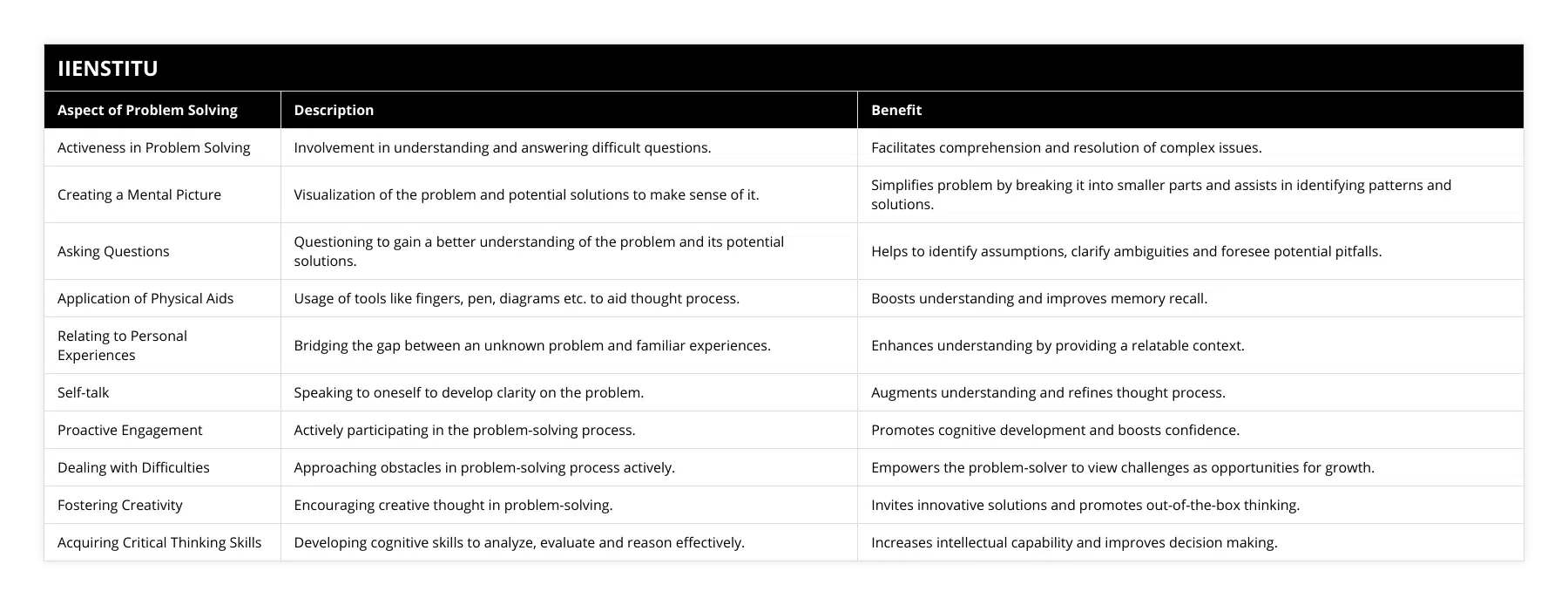
In the book "Thinking, Fast and Slow" by Daniel Kahneman (Kahneman, 2011), the author emphasizes the importance of slow, deliberate thinking—often facilitated by asking insightful questions.
Bridging Problems with Familiar Experiences
Linking new problems to familiar scenarios makes them less daunting. I recall struggling with statistics until I started relating probability to card games I played with friends. Suddenly, concepts like odds and variance weren't just numbers on a page—they were strategies I used every weekend!
Connecting problems to real-life can:
Make abstract concepts concrete.
Increase engagement and interest.
Facilitate quicker understanding.
Provide practical applications.
Physical Aids and Tools
Sometimes, thinking isn't just about what's in our heads. Using physical aids can significantly enhance our problem-solving abilities.
Tools to Enhance Thinking:
Diagrams and Charts: Visual representations of data.
Physical Objects: Using items like blocks or models to represent parts of a problem.
Writing Things Down: Jotting notes can clarify thoughts.
Digital Tools: Software programs that simulate problems.
After all, even Einstein was known for using chalkboards filled with equations to visualize his groundbreaking theories!
Benefits of Being Active in Problem Solving
Embracing an active approach doesn't just solve the immediate problem—it builds lifelong skills.
Advantages include:
Enhanced critical thinking abilities.
Improved creative thinking, leading to innovative solutions.
Greater confidence in tackling unfamiliar challenges.
Development of a proactive mindset.
Better academic performance overall.
In a study titled "Active Engagement and Student Success" published in the Journal of Educational Psychology (Brown & Lee, 2018), students who actively engaged with their coursework were found to have a 15% higher academic performance than their less engaged peers.
Strategies to Enhance Your Problem-Solving Skills
Ready to become a better problem solver? Here are some tried-and-true tips:
1- Embrace Challenges: View problems as opportunities to learn.
2- Stay Curious: Never stop asking questions.
3- Practice Regularly: Like any skill, practice makes perfect.
4- Collaborate with Others: Two heads are often better than one.
5- Reflect on Past Solutions: Learn from previous experiences.
Remember, it's not about always getting the right answer immediately but about the process of exploration and discovery.
The Role of Active Problem Solving in Supply Chain Management
You might be wondering, how does this relate to the real world? Let's consider supply chain management—a field that requires constant problem-solving and optimization.
By being active in addressing issues, professionals can optimize supply chain management process tips effectively. They can:
Visualize the entire supply chain to identify bottlenecks.
Ask critical questions about logistics and operations.
Use physical aids like flowcharts and models.
Engage with team members to brainstorm solutions.
Incorporating active problem-solving strategies can lead to more efficient operations, cost savings, and a competitive edge in the market.
The Final Piece of the Puzzle
At the end of the day, the key to unlocking effective problem-solving lies within us. It's about being proactive, staying engaged, and constantly challenging ourselves. Life throws countless puzzles our way, but with an active approach, we can tackle them head-on.
So next time you're faced with a daunting problem, take a step back. Create that mental picture, ask those pressing questions, and dive deep. You might just surprise yourself with the solutions you discover.
References
Brown, L., & Lee, K. (2018). Active Engagement and Student Success. Journal of Educational Psychology, 110(3), 345-357.
Kahneman, D. (2011). Thinking, Fast and Slow. Farrar, Straus and Giroux.
Smith, J. (2015). The Cognitive Benefits of Visualization. Cognitive Science Press.
Frequently Asked Questions
What are the benefits of being active in problem solving?
Being active in problem-solving can be an essential part of life, especially for those in the workplace or educational settings. In addition, problem-solving can help individuals develop their critical thinking and problem-solving skills, which can benefit personal and professional development.
The first benefit of being active in problem-solving is that it can help individuals to develop their critical thinking and problem-solving skills. Thinking critically and solving problems can assist individuals in making decisions, identifying solutions, and developing strategies to address challenges. With these skills, individuals can more effectively manage their own lives as well as contribute to the lives of others.
The second benefit of being active in problem-solving is that it can help individuals to become better communicators. When individuals actively engage in problem-solving, they can think critically and express their ideas clearly and concisely. This improved communication can help individuals work more effectively with others and collaborate on projects.
The third benefit of being active in problem-solving is that it can help individuals to become more self-reliant. When individuals actively engage in issue-solving, they can think for themselves and develop solutions and strategies. This can help individuals to gain a greater sense of self-confidence and autonomy and can also help them to become more independent and resourceful.
Finally, being active in problem-solving can help individuals to become more creative and innovative. When individuals actively engage in issue-solving, they can think outside and create creative solutions to complex problems. This can benefit both personal and professional development, as individuals can tap into their creative potential to develop unique ideas that can be beneficial in various settings.
In conclusion, being active in problem-solving can provide numerous benefits for individuals. It can help individuals develop their critical thinking and problem-solving skills, become better communicators, become self-reliant, and become more creative and innovative. As such, being active in problem-solving can be an essential part of life for those in the workplace or educational settings.
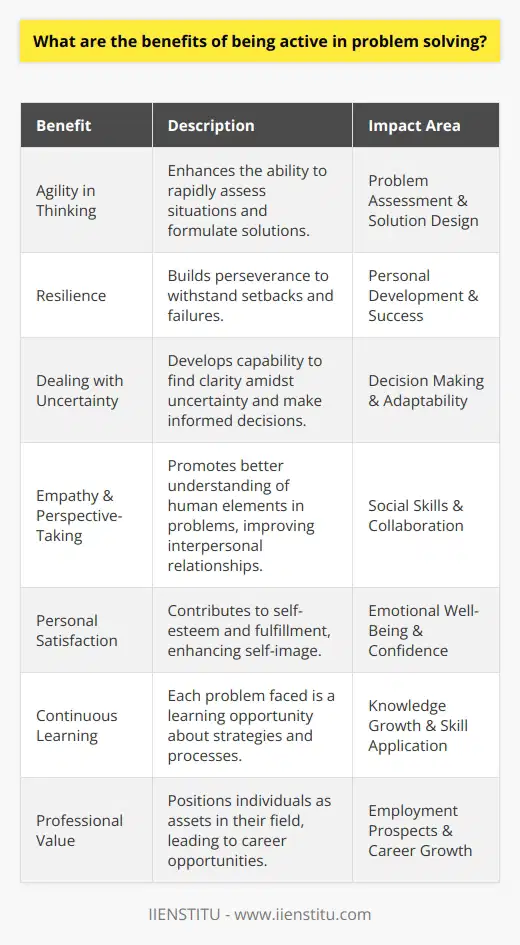
How can I create a mental picture to help me solve a problem?
Creating a mental picture can help us solve problems in innovative and creative ways. By better understanding the problem, we can use our imagination to create a visual representation of the information, which allows us to analyze it more effectively.
When creating a mental picture, it is essential to focus on the critical elements of the problem. Start by breaking down the problem into its core components, such as the people, resources, and obstacles involved. This will allow you to create a more detailed mental picture of the problem. Then, consider how each element interacts with the other and how they can be used to find a solution.
The next step is to create an image in your mind of the problem you are trying to solve. Then, visualize the elements of the situation in a way that makes it easier to understand. This could involve creating a diagram or flowchart that outlines the main points of the problem. Alternatively, you could create a storyboard or timeline to help you visualize the problem.
Once you have created a mental picture of the problem, it is essential to analyze it. Ask yourself questions such as "What can I do to make this better?" and "What resources do I need to solve this problem?" These questions will help you identify the problem's solutions more efficiently.
Finally, it is essential to remember that creating a mental picture is just one step in problem-solving. After making the mental image, you will still need to implement your identified solutions. This could involve creating an action plan or setting goals to help you achieve the desired outcome.
In conclusion, creating a mental picture can be an effective way to solve problems. By breaking down the problem into its core elements, visualizing it in your mind, and analyzing it, you will be better equipped to find creative and innovative solutions to the problem.
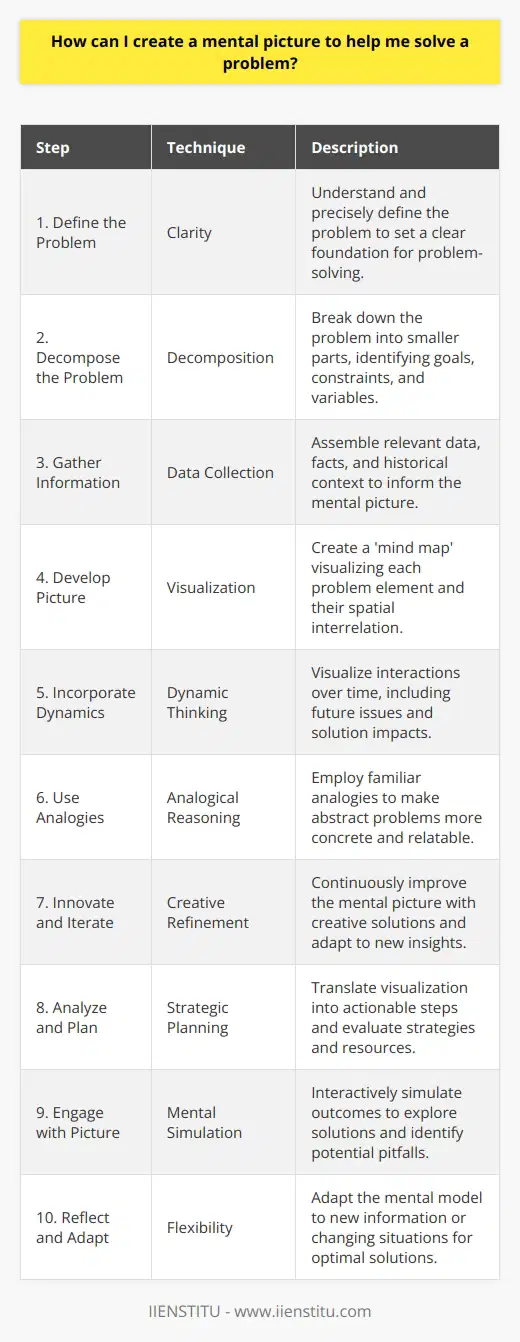
What types of questions should I ask when trying to unlock problem solving?
Problem-solving is a complex process that requires a great deal of mental effort. Therefore, asking the right questions is one of the most critical aspects of problem-solving, as it helps to uncover the root of the issue and to identify potential solutions. When trying to unlock problem-solving, asking open-ended questions for multiple interpretations is essential. Additionally, questions should be specific and focus on the problem.
When trying to unlock problem-solving, asking questions that help identify an issue's underlying causes is essential. For example, asking questions such as "What led to this problem?" or "What is the root cause of this issue?" can help uncover the issue's source and develop a plan for addressing it. Additionally, asking questions that focus on the problem's effects can help identify potential solutions. For example, questions such as "What are the consequences of this problem?" or "What will happen if the problem is not addressed?" can help to identify the potential consequences of not addressing the issue and to develop a plan for addressing it.
Questions should also be specific. Asking broader questions such as "What should I do?" or "How can I solve this problem?" can lead to vague answers that do not provide meaningful insight into the problem. Instead, it is essential to ask questions that are specific to the issue at hand. For example, if the problem is related to a lack of resources, asking questions such as "What resources are needed to address this issue?" or "What resources are available to address this issue?" can help to identify the resources that are available and to develop a plan for utilizing them.
Finally, it is essential to ask questions that allow for multiple interpretations. Questions that are too narrow or have a single correct answer can limit the potential solutions to the problem. Instead, asking questions that allow for multiple interpretations and encourage creative thinking is essential. For example, asking questions such as "What other potential solutions could there be?" or "What other approaches could be taken to address this issue?" can help to identify potential solutions that would not have been considered otherwise.
In conclusion, asking the right questions is essential in unlocking problem-solving. It is important to ask open-ended questions that focus on the issue's underlying causes and allow for multiple interpretations. Additionally, questions should be specific to the topic and focus on identifying potential solutions. By following these guidelines, it is possible to unlock effective problem-solving.
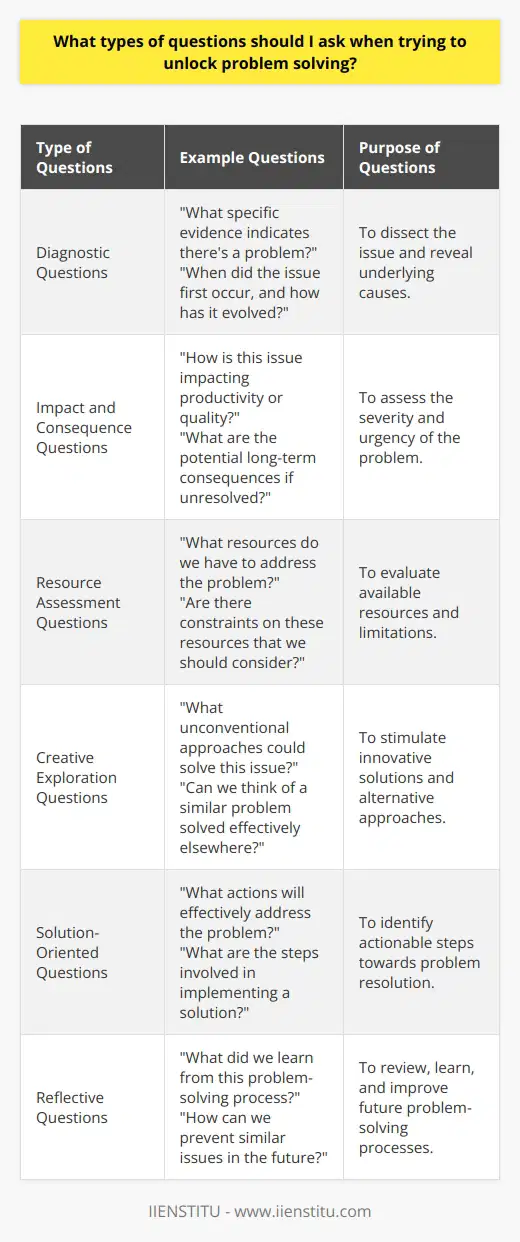
What is the key to effective problem-solving in complex situations?
Key Aspects of Effective Problem-Solving in Complex Situations
Understanding the Problem
The key to effective problem-solving in complex situations starts with a thorough understanding of the problem. This involves breaking down the issue into smaller components and analyzing each element. By doing this, one can identify the root causes and develop a better perspective on the challenge at hand.
Critical Thinking and Creativity
Critical thinking and creativity are essential tools for addressing complex problems. Critical thinking allows for the evaluation of multiple perspectives, ensuring an unbiased approach to the problem. Creativity, on the other hand, introduces novel solutions or ways to view the issue, which may otherwise remain undiscovered.
Adaptability and Flexibility
Complex situations often require a dynamic approach as they can be multifaceted and interconnected. Adopting an adaptable and flexible mindset allows for the assessment and reassessment of strategies as new information emerges. This skill is crucial as it reduces the chance of becoming fixated on a single solution and ensures that all options are considered.
Collaboration and Teamwork
Complex problems can rarely be solved by an individual alone. A collaborative approach, leveraging the collective knowledge and skills of a diverse team, enables a broader understanding of the situation. Employing effective communication strategies and learning from the experiences and ideas of others fosters a conducive environment for problem-solving.
Decision-Making and Implementation
Finally, effective decision-making and implementation are crucial components of problem-solving. Once a solution has been identified, it is important to evaluate the feasibility, risks, and constraints involved in its implementation. Moreover, actively monitoring the progress and outcomes of the solution, and adapting as necessary, is essential to ensure its success in the long run.
In conclusion, the key to effective problem-solving in complex situations lies not in a single attribute but rather in the harmonious application of understanding the problem, critical thinking, creativity, adaptability, collaboration, and the ability to make sound decisions and effectively implement them. By cultivating these skills, one can improve their problem-solving capabilities and navigate complex situations with greater ease and success.
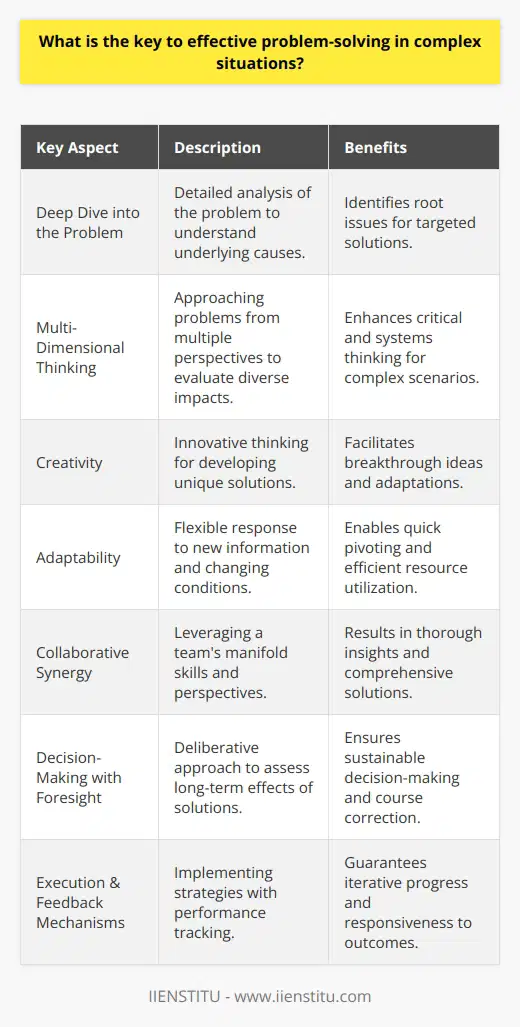
How do the 7 steps of problem-solving ensure a comprehensive approach to addressing challenges?
Understanding Problem-Solving Steps
The seven-step problem-solving model ensures a comprehensive approach to addressing challenges by systematically breaking the problem down into manageable components. Each step contributes to a more effective solution by facilitating an organized thought process and encouraging open communication among stakeholders.
Identifying the Problem
Firstly, understanding the problem is essential for successful problem-solving. Identifying the issue ensures that the solution tackles the core concern, setting a constructive path forward. Clear definitions and objectives contribute to a consistent, unified understanding among stakeholders.
Gathering Relevant Information
Secondly, the gathering of relevant information is crucial for informed decision-making. This ensures that any proposed solution is firmly grounded in facts, taking into account past experiences, possible repercussions, and available resources, reducing uncertainty and driving better results.
Identifying Root Causes
Thirdly, determining the problem's underlying causes through thorough analysis helps create efficient solutions. Addressing root causes eliminates the issue at its source, preventing the recurrence of similar problems in the future. This fosters a proactive approach and minimizes wasted resources.
Developing Potential Solutions
Fourthly, brainstorming potential solutions encourages creativity and innovation, maximizing the possibility of discovering the most effective answer. This open exchange of ideas allows stakeholders to explore diverse perspectives, ultimately leading to a comprehensive and inclusive solution.
Evaluating Possibilities
Fifthly, evaluating potential solutions allows decision-makers to compare pros and cons, examining each option's feasibility before implementation. This step helps avoid any unforeseen consequences and ensures resources are allocated effectively to the most appropriate solution.
Selecting the Best Solution
Sixthly, selecting the best option involves a collaborative decision-making process, taking into account stakeholder input and aligning solutions with the overall objectives. This ensures buy-in from stakeholders, leading to a successful implementation of the chosen solution.
Implementing and Monitoring
Lastly, implementing the chosen solution and monitoring its effectiveness ensure continuous improvement and adaptation. Adjustments may be required if the initial solution does not lead to desired outcomes, and tracking progress can help identify areas for modification.
In conclusion, the seven-step problem-solving model provides a well-rounded, systematic approach to addressing challenges. By following these steps, one can ensure that their solutions are comprehensive, effective, and adaptable.
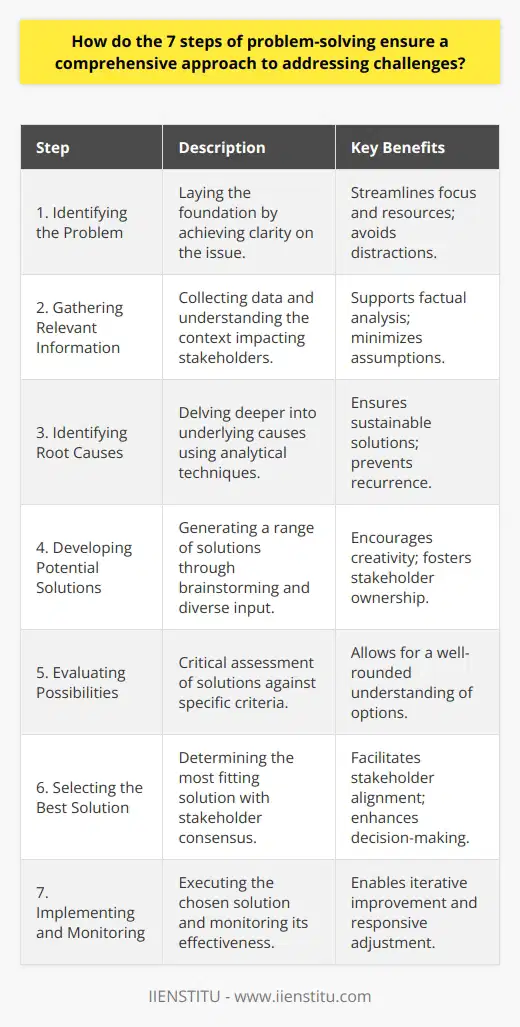
In what ways can the 3 problem-solving techniques be applied across various disciplines to generate innovative solutions?
Problem-Solving Techniques in Different Disciplines
Applying Creativity
One way that the three problem-solving techniques, namely brainstorming, the six thinking hats, and the 5 whys, can be applied across various disciplines is by fostering creativity. These techniques help people produce new ideas and discover unique solutions by encouraging them to think outside of the box. In scientific research, for instance, brainstorming can lead to new hypotheses, while using the six thinking hats can help evaluate different perspectives on an issue in social science or philosophy.
Enhancing Collaboration
Another aspect of these problem-solving techniques is their ability to foster collaboration among team members. In interdisciplinary teams, individuals often hold different knowledge and skills. Brainstorming and the six thinking hats promote open communication and the sharing of diverse viewpoints to generate innovative solutions. For instance, in a business setting, the six thinking hats method can improve decision-making by allowing team members to approach problems from varying angles and combining their expertise.
Promoting Critical Thinking
The final benefit of these problem-solving techniques is their potential to strengthen critical thinking abilities. This is especially true for the 5 whys technique, which employs a systematic approach to identify the root cause of an issue. When applied across disciplines, this method teaches practitioners to thoroughly analyze a problem and question their assumptions. For example, in medicine, the 5 whys can be used to determine the underlying cause of a patient's symptoms, leading to more accurate diagnoses and more effective treatments.
In conclusion, the problem-solving techniques of brainstorming, the six thinking hats, and the 5 whys offer valuable tools for fostering creativity, collaboration, and critical thinking in various disciplines. Applying these strategies can help individuals and teams generate innovative solutions to complex problems, making them widely applicable and beneficial in numerous fields.

What are the 5 key problem-solving skills, and how can they be developed and enhanced in educational settings?
Developing Problem-Solving Skills in Education
Analytical Thinking
One of the essential problem-solving skills is analytical thinking, which entails breaking down complex problems into smaller, manageable components. This skill can be nurtured in educational settings by engaging students in activities such as brainstorming, critical analysis, and grouping or categorizing information. Educators can provide real-life examples or case studies for students to analyze and discuss, fostering their ability to examine problems systematically.
Creativity and Innovation
Nurturing creativity and innovation in students is vital for developing their ability to approach problems from various perspectives. Educators can encourage creativity by providing open-ended assignments, promoting brainstorming sessions, and incorporating artistic or multimedia elements into lessons. They can also create an environment that supports constructive risk-taking and experimentation, as well as celebrating unique and innovative ideas.
Collaboration and Teamwork
Working together effectively is indispensable for successful problem-solving. In educational settings, this skill can be strengthened through group activities, projects, and cooperative learning opportunities. Educators should emphasize the importance of active listening, respectful disagreement, and compromise while encouraging diverse perspectives to enhance the group's collective problem-solving ability.
Adaptability and Flexibility
In a world marked by rapid change, adaptability and flexibility are crucial problem-solving skills. Educators can facilitate the development of these traits by encouraging students to explore new subjects, take on new challenges, and embrace failure as part of the learning process. Providing ongoing feedback, setting achievable goals, and celebrating progress can also assist in developing adaptable and flexible mindsets.
Effective Communication
Clear and concise communication is an essential aspect of problem-solving. Educators can support students in refining their written and oral communication skills through presenting complex ideas and materials, engaging in class discussions, and providing constructive feedback on written assignments. Fostering a classroom culture that values empathy, active listening, and asking questions can contribute to cultivating effective communicators.
In summary, fostering problem-solving skills in educational settings encompasses supporting students in developing analytical thinking, creativity and innovation, collaboration and teamwork, adaptability and flexibility, and effective communication. By incorporating diverse activities and projects that focus on these key skills, educators can equip their students with the necessary tools to tackle challenges and become successful problem-solvers in various aspects of life.

How does fostering a growth mindset contribute to the development of effective problem-solving abilities?
The Role of a Growth Mindset
Fostering a growth mindset plays a crucial role in developing effective problem-solving abilities. A growth mindset is the belief that intelligence and abilities can improve through effort and learning (Dweck, 2006). This mindset promotes resilience and persistence when facing challenges.
Developing Adaptive Strategies
Individuals with a growth mindset tend to develop adaptive strategies that help them overcome obstacles. They are more likely to view setbacks as opportunities to grow, and actively seek feedback to enhance their skills (Yeager & Dweck, 2012). Through this iterative process, they become better at identifying and implementing solutions to problems.
Enhancing Intrinsic Motivation
A growth mindset also enhances intrinsic motivation by fostering a love of learning and a passion for self-improvement (Dweck, 2006). This inner drive stimulates curiosity and promotes engagement in problem-solving activities. Furthermore, intrinsic motivation increases the willingness to take risks and explore novel approaches, leading to more creative solutions (Haimovitz & Dweck, 2016).
Building Cognitive Flexibility
Cognitive flexibility is the ability to adapt one's thinking to diverse situations and readily switch between different mental tasks (Spiro & Jehng, 1990). Fostering a growth mindset cultivates cognitive flexibility as individuals focus on broadening their understanding and expanding their skill set. This mental agility helps them reconceptualize problems, identify patterns, and generate innovative ideas for effective problem-solving.
Encouraging Collaboration and Knowledge Sharing
Lastly, a growth mindset promotes collaboration and knowledge sharing, crucial components of effective problem-solving. As individuals understand that learning is a collective process, they are more open to seeking help, exchanging ideas, and building on others' insights (Murphy & Dweck, 2010). This open-mindedness facilitates the development of diverse perspectives and fosters a more comprehensive understanding of the problem at hand.
In conclusion, fostering a growth mindset contributes to the development of effective problem-solving abilities by promoting adaptive strategies, enhancing intrinsic motivation, building cognitive flexibility, and encouraging collaboration and knowledge sharing. Cultivating this mindset is, therefore, essential for individuals and organizations seeking to excel in an increasingly complex world.

In what ways can the incorporation of multidisciplinary perspectives enhance problem-solving techniques, and how can educators encourage such collaboration?
Multidisciplinary Approaches Enhancing Problem-Solving Techniques
Incorporating multidisciplinary approaches into problem-solving techniques can significantly enhance the processes and outcomes in various ways. One key advantage is the broadening of perspectives by combining knowledge and expertise from diverse fields. This fosters creativity and innovation, as individuals are challenged to think beyond their disciplinary boundaries and develop fresh, holistic solutions. Additionally, multidisciplinary collaboration can facilitate systems thinking, which allows for a more comprehensive understanding of the interrelated components and factors involved in complex problems. This enables more effective strategies that consider the dynamics and interactions within the problem’s ecosystem.
Promoting Collaboration Through Educational Strategies
Educators have an essential role in encouraging multidisciplinary collaboration among students. One effective strategy is designing curricula that prioritize interdisciplinary learning experiences, blending concepts and theories across different subject areas, and requiring students to apply their knowledge in integrated projects or assignments. This approach not only exposes students to various disciplines but also fosters an appreciation for the interconnectedness of knowledge and the value of diverse expertise in solving complex problems.
Developing Teamwork and Communication Skills
Another crucial aspect of promoting multidisciplinary collaboration is teaching students essential teamwork and communication skills. Educators can provide opportunities for students to work in diverse, interdisciplinary groups, encouraging them to share their expertise, listen and learn from each other, and collaborate towards a common goal. Activities like group projects, case studies, and simulations can facilitate these skill-building experiences, highlighting the importance of effective communication and collaboration in problem-solving.
Cultivating a Culture of Curiosity and Openness
Finally, educators can cultivate a culture of curiosity and openness in the classroom, emphasizing the importance of questioning assumptions, seeking alternative perspectives, and challenging conventional wisdom. This can be achieved by creating an inclusive learning environment that values diverse perspectives and invites critical discourse, as well as by modeling curiosity and open-mindedness in their teaching practices. Providing students with examples of successful multidisciplinary collaborations that have led to breakthroughs and innovations can also be inspirational and help foster a belief in the power of interdisciplinary approaches to problem-solving.
In conclusion, incorporating multidisciplinary perspectives into problem-solving techniques can greatly enhance the process and outcomes by fostering creativity, innovation, and systems thinking. Educators can encourage collaboration by designing interdisciplinary curricula, promoting teamwork and communication skills, and cultivating a culture of curiosity and openness.
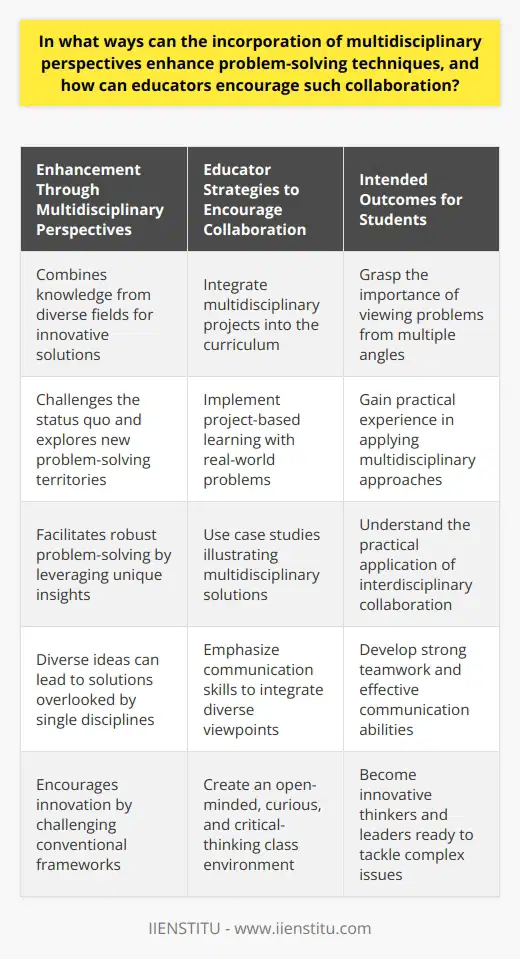
What are the fundamental principles of active problem-solving, and how do they promote effective resolution of challenges?
Fundamental Principles of Active Problem-Solving
Active problem-solving is based on several key principles, which, when applied in a systematic manner, enable individuals and organizations to effectively resolve challenges. These principles are:
Identifying the problem:
Realizing the presence of a problem and defining it in clear terms is the first step towards a successful resolution. Better understanding of the issue at hand paves the way for informed decision-making.
Analyzing the problem:
Examining the problem thoroughly through various perspectives helps to uncover its root causes. Assessing factors such as feasibility, resources, and constraints is an integral part of this analysis.
Generating potential solutions:
Generating several possible solutions is a crucial step in the problem-solving process. This allows for the development of creative and innovative alternatives while also considering traditional approaches.
Evaluating and selecting solutions:
After identifying multiple potential solutions, each one should be systematically evaluated based on predetermined criteria, such as effectiveness, cost, and possible side-effects. Following this evaluation, the most suitable solution can be selected.
Implementing the solution:
Once the ideal solution has been chosen, it should be implemented with a well-crafted plan. Consideration of timelines, resource allocation, and various stakeholders' input is important in this phase.
Monitoring and adjusting:
After the solution has been implemented, ongoing monitoring allows for the identification of any unforeseen issues or necessary adjustments. This iterative process ensures that the problem-solving approach is continuously refined and improved.
In conclusion, the fundamental principles of active problem-solving contribute to effective resolution of challenges by encouraging a systematic, comprehensive, and adaptable approach. The application of these principles can empower individuals and organizations to tackle complex issues with confidence and achieve their desired outcomes.
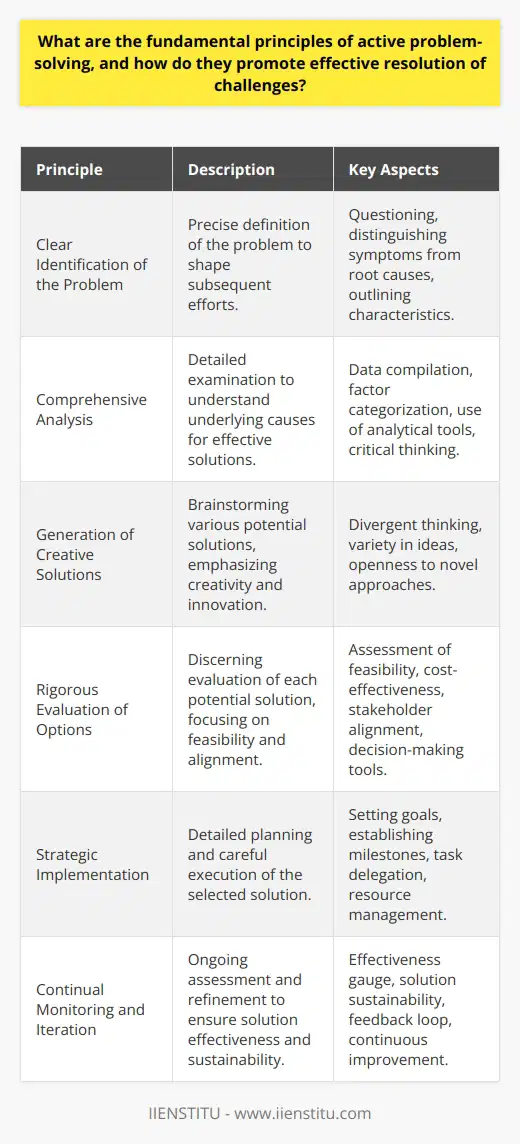
How can the incorporation of the 7 steps to problem-solving into decision-making processes lead to improved outcomes in various professional settings?
Incorporation of the 7 Steps in Professional Settings
Utilizing the 7 steps to problem-solving in decision-making processes can significantly enhance outcomes in various professional settings. This approach promotes a structured and systematic examination of issues, resulting in more informed decisions.
Step 1: Identify the Problem
Clearly defining the problem allows professionals to gain a deeper understanding of the issue at hand. It facilitates accurate diagnosis and assessment, paving the way for more effective solutions.
Step 2: Gather Information
Collecting relevant data and information equips professionals with the necessary knowledge to make informed decisions. This step reduces uncertainty and increases the likelihood of selecting the best course of action.
Step 3: Develop Alternatives
Exploring various possibilities expands professionals’ perspectives, enabling them to generate diverse and creative solutions. This comprehensive approach promotes adaptability and resilience in the face of complex problems.
Step 4: Analyze Alternatives
Examining the pros and cons of each alternative allows professionals to make well-informed decisions. By assessing the feasibility and potential consequences, it becomes possible to select the most appropriate resolution to an issue.
Step 5: Select the Best Alternative
After careful deliberation, the optimal solution is chosen. This step ensures that both short-term and long-term implications have been considered, increasing the potential for successful outcomes.
Step 6: Implement the Solution
Timely and efficient execution of the chosen strategy is crucial in achieving desired outcomes. This step involves clear communication, resource allocation, and contingency planning to ensure a smooth implementation process.
Step 7: Evaluate and Learn from the Process
Continuous evaluation of the implemented solution and the overall problem-solving process enables professionals to refine their skills, identify areas for improvement, and make future decisions more effectively.
In conclusion, the incorporation of the 7 steps to problem-solving in professional decision-making processes enhances overall effectiveness, efficiency, and adaptability. By fostering a systematic, comprehensive approach to addressing challenges, professionals across various industries can improve outcomes and thrive in the dynamic nature of their respective fields.

What is the role of critical thinking and creativity in enhancing problem-solving ability and generating innovative solutions to complex issues?
The Importance of Critical Thinking
In enhancing problem-solving abilities, the role of critical thinking cannot be overstated. Critical thinking enables individuals to evaluate information, recognize underlying assumptions, and identify possible solutions systematically. By engaging in reflective and independent thinking, individuals learn to discern the relevance of various aspects, assess credibility of sources, and make well-informed decisions.
Innovative Solutions Through Creativity
Alongside critical thinking, creativity plays a crucial part in generating innovative solutions to complex issues. Creativity involves transcending traditional thought patterns, giving rise to fresh ideas and original approaches to problem-solving. By embracing diverse perspectives and nurturing a culture of open-mindedness, individuals and teams alike can challenge conventional methods and innovate in unique ways.
The Synergy between Critical Thinking and Creativity
It is essential to recognize that critical thinking and creativity are not mutually exclusive, but rather complementary skills. By synergizing the logical rigor of critical thinking with the imaginative flair of creativity, individuals can generate holistic, versatile, and effective solutions. Such a dynamic interplay between both skills sharpens one's problem-solving ability, addressing immediate concerns while maintaining a long-term view for sustainable solutions.
Promoting a Mindset for Innovation
To develop these skills, individuals must cultivate a mindset that prioritizes innovation, a task made easier through educational initiatives designed to foster critical thinking and creativity. Educators play a pivotal role in nurturing these abilities, incorporating strategies such as brainstorming, debate, and collaboration, among others into curricula. By emphasizing these core competencies, students, professionals, and organizations collectively benefit from an environment that encourages creative problem-solving and innovative thinking.
In conclusion, both critical thinking and creativity are central to enhancing problem-solving abilities and generating innovative solutions to complex issues. Merging analytical thought and ingenious imagination allows individuals to tackle challenges with a comprehensive understanding of various dimensions. By emphasizing these skills in educational systems and professional settings, society stands to benefit from a population adept at facing the multifaceted problems of the modern world.

